
views
Choosing the Right Container
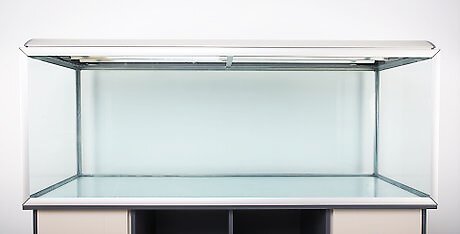
Turn a fish tank into a simple terrarium for an affordable option. Glass enclosures are generally easier to find and cheaper. Look for an old fish tank you can use. Clean it out so you can set up a stable environment for your gecko. Look for old fish tanks at local thrift shops or pet supply stores. You can usually find them easily.
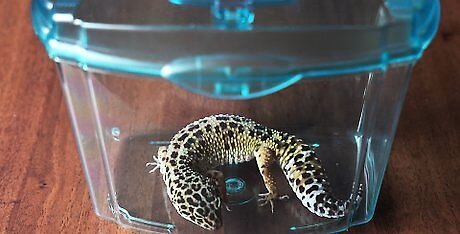
Go with a plastic container for a durable option. Both plastic and glass are resistant to mold and easy to sanitize, but plastic enclosures can be a little more expensive. However, plastic won’t break or crack as easily as glass. Find a clean plastic container or use a plastic reptile enclosure to give your reptile a happy home. Look for plastic boxes or containers at your local department or hardware store. You can also order them online. You could even use a solid-colored PVC container for an enclosure.
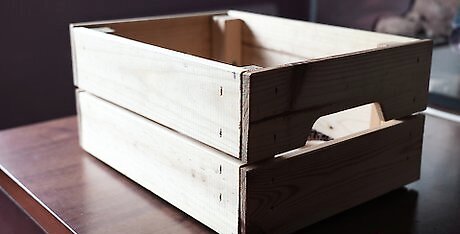
Make or choose a wooden enclosure for better insulation. Wooden containers will help retain heat better, but they’re more prone to mold. Find a clean wooden box or make a simple one yourself that you can use for a simple enclosure. Another advantage of using a wooden box is you can use screws to mount accessories such as heating lamps or light fixtures.
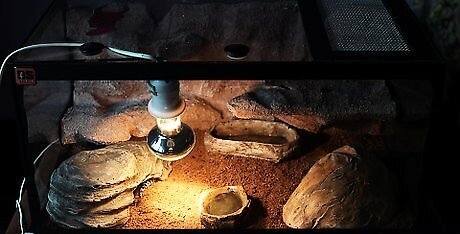
Use a tank or container that holds 20 gallons (76 L) per gecko. No matter what material you use, make sure the enclosure has at least 2.5 square feet (0.23 m) of floor space, is at least 2 feet (0.61 m) long, and is tall enough so your gecko’s movement isn’t restricted. Choose an enclosure large enough to hold 20 gallons (76 L), which will make sure your little reptile has plenty of room. If you have multiple geckos, add an extra 2 square feet (0.19 m) of floor space per additional gecko to make sure they all have enough room. A single young leopard gecko will do fine in a 10 US gal (38 L) enclosure. But you’ll want to upgrade them to a larger one when they mature.
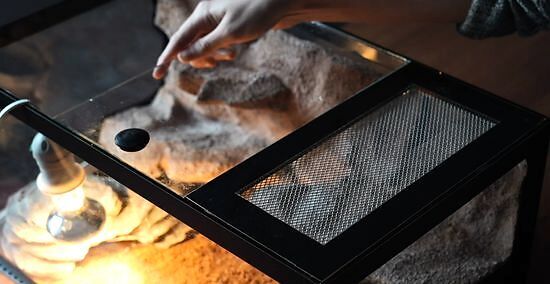
Cover the enclosure with a screened lid. Choose a screen with holes small enough to prevent your gecko from climbing out. Place the screen on top of your enclosure and place a small weight on top so it doesn’t come off. Leopard geckos actually don’t have the same pads on their hands like other geckos, so they’re unlikely to climb out. But still, better to be safe than sorry! Use a screen so there’s plenty of ventilation in the enclosure.
Creating the Right Environment
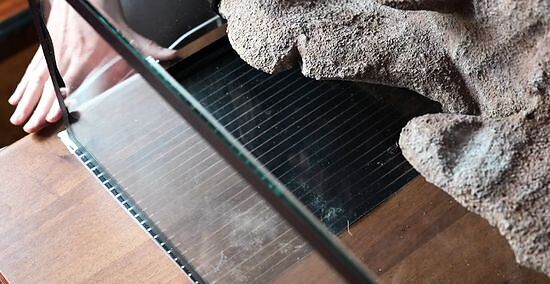
Place an under tank heating pad beneath ⅓ of your tank. An under tank heating pad is a heating pad that sticks to the underside of the tank to provide a continuous source of warmth for your gecko. Peel off the sticky adhesive and stick the pad to the underside of your enclosure, covering about ⅓ of the total area so your gecko has different temperature zones to choose from. Leopard geckos self-regulate their body temperatures by moving to different regions of their habitat. So it’s important to have a warmer area and a cooler area of the enclosure.
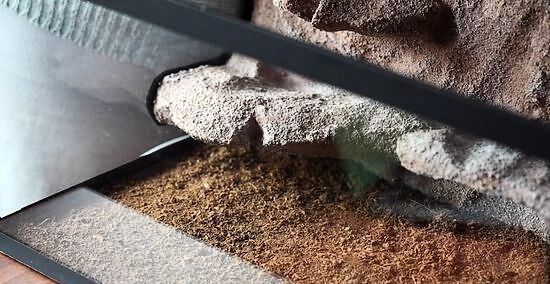
Cover the floor of the enclosure with substrate. Substrate is material that helps insulate the floor of your enclosure and make it more comfy for your gecko. For a cheap, disposable option, take sheets of paper towels and lay them flat along the floor of the enclosure to form an even layer. For a more durable option, take pieces of slate or ceramic tiling and arrange them along the floor of your enclosure to simulate the rocky terrain of a leopard gecko’s natural habitat. Paper towels make great substrates and they’re easy to clean—you just swap them out for fresh ones when they get dirty! To clean slate or ceramic tiles, you can simply take them out and wipe them down whenever they get too dirty. Avoid using sand or loose substrate. Your gecko may accidentally eat sand or substrate made out of small, loose materials.
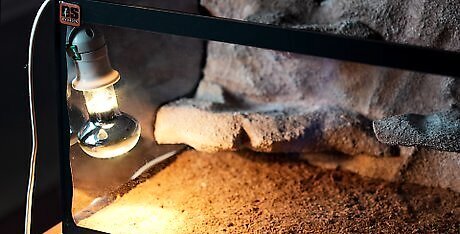
Add a reptile heat lamp on top of the enclosure. Use a heat lamp designed for reptile enclosures to add a little more light and heat during the day, which replicates a leopard gecko’s natural environment. Clip the lamp to the top of the enclosure with the light shining down into it. You can find reptile heat lamps at pet supply stores. You can also order them online. Keep your enclosure in ideal temperature ranges with your lamp. On the cool side, the ideal temperature is between 75–80 °F (24–27 °C). Ideally, the warm side (above the heating pad) should be in the 85–90 °F (29–32 °C) range.
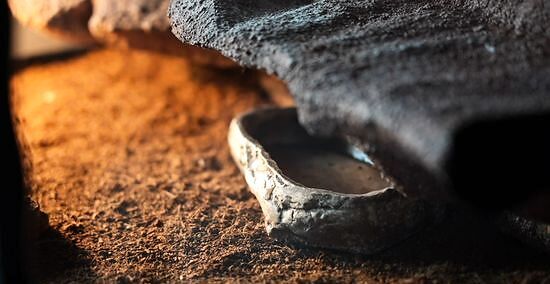
Place a food and water dish in the enclosure. Choose a reptile food and water bowl or use small saucers. Place them into the enclosure so you can use them to feed and supply water to your gecko. Reptile water bowls are great because their anti-microbial and won’t develop bacteria as easily. Reptile food bowls are designed so insects like mealworms can’t climb out as easily.
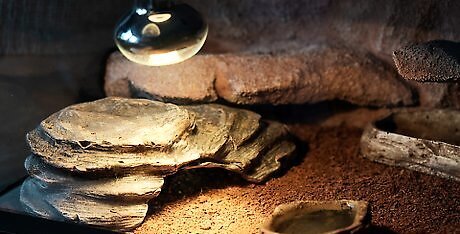
Place a hiding spot in the warm section of the enclosure. Use reptile hides (small objects you can find at pet supply shops) or make a simple hide by cutting a hole in a clean margarine container. Place 1 in the warm area of the enclosure and place some damp sphagnum moss inside so it gets nice and humid. Your gecko doesn’t just want hiding spots, they actually need them to help regulate their body temperature. You can use really any plastic container. Just make sure it’s clean and you cut a hole large enough for your gecko to fit inside.
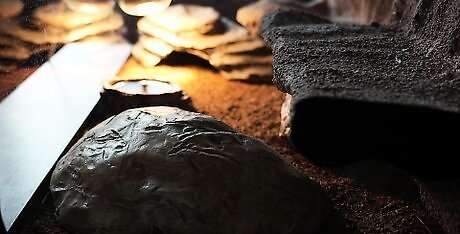
Put another hiding spot in the cooler section of the enclosure. Choose another hide or make another one you can use. Add it to the cooler area of the tank to give your gecko options when it’s trying to regulate its body temperature. You need at least 2 hiding spots in your enclosure, but you’re more than welcome to place more than 2 hiding spots for your gecko! They love hanging out in them. If you have more than 1 gecko, have at least 2 hiding spots for each.
Introducing Your Leopard Gecko
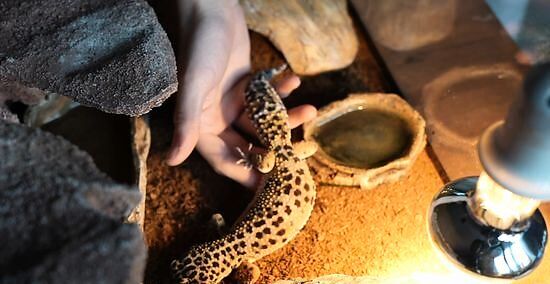
Place your gecko gently into the enclosure. Pick up your gecko calmly so they don’t get stressed. Carefully place it into the enclosure and then close the lid. Give your gecko some time to get acquainted with it’s new home. If your gecko heads straight for a hiding spot, don’t worry. It may take some time for it to get comfortable in the enclosure.
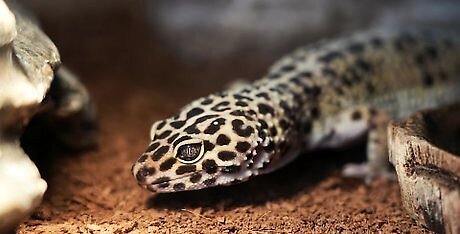
Avoid putting 2 males in the same enclosure. If you have multiple leopard geckos, trying putting females together or a max of 1 male. Male geckos can become territorial and aggressive if they’re in the same habitat, so it’s best to keep them apart.
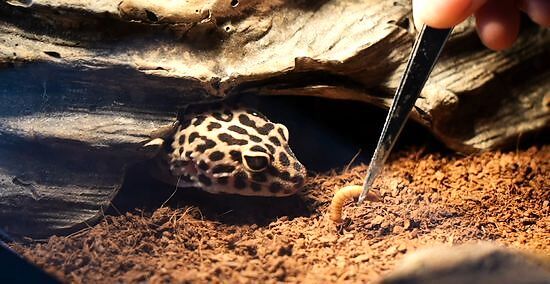
Feed your gecko a variety of live or canned insects. Geckos love and need a varied diet of different insects such as crickets, mealworms, and grasshoppers. You can add live insects into the enclosure or use canned ones. Place an insect in the food bowl and allow your gecko to eat when it’s hungry. You can find insects for your gecko at pet supply stores. You can even order them online to have them sent straight to your home.

Turn your heat lamp off at night. Leopard geckos are active at night, so it’s important that you set up your enclosure to mimic their natural cycles. Turn off the lamp at night so they have periods of cooler and darker temperatures, which will more accurately reflect their natural habitats.




















Comments
0 comment